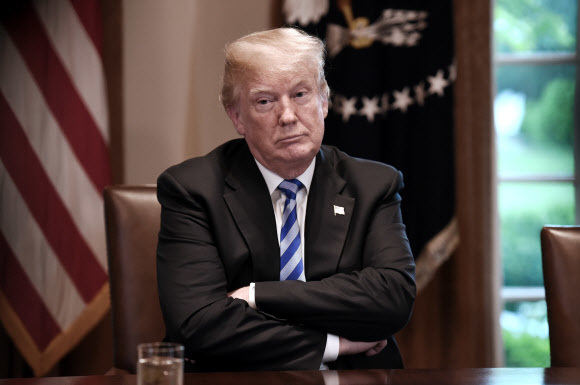Posted on : May.18,2018 17:31 KST
Modified on : May.18,2018 17:53 KST
 |
|
US President Donald Trump crosses his arms at a meeting with California bureaucrats in the White House on May 16. (UPI/Yonhap News)
|
Press Secretary Sanders emphasizes it is not seeking “Libya model of denuclearization”
After North Korea brought up the possibility of backing out of the summit it has scheduled with the US because of its opposition to the Libyan model of denuclearization, the White House categorically stated that it is not advocating the Libya model. The White House is apparently trying to mollify the North without directly engaging with its objections.
“I know that that comment was made, but I don't think we're going off of” it, White House Press Secretary Sarah Huckabee Sanders told reporters on May 16 when asked about the Libyan model to denuclearization, in which a country is only rewarded after it has abandoned its nuclear program.
"I haven't seen that as part of any discussions, so I'm not aware that that's a model that we're using,” Sanders said. “There's not a cookie-cutter model on how this works."
Sanders said that what the US government is using to resolve the North Korean nuclear issue is “the President Trump model.” “He's going to run this the way he sees fit," Sanders said. “We're very confident in that front."
Sanders’ remarks have important implications for breaking out of the current crisis, which could put North Korea-US preliminary negotiations in a deadlock. Since the press secretary’s remarks represent the US government’s official position, they take precedence over National Security Advisor John Bolton’s remarks to Fox News on May 13 that the US is considering the Libya model.
 |
|
White House National Security advisor John Bolton attends a summit at the White House between US President Trump and Uzbek President Shavkat Mirziyoyev on May 16. (Reuters/Yonhap News)
|
In other words, given North Korea’s concerns about the fact that the Libyan government under Col. Muammar el-Qaddafi collapsed after it gave up its nuclear program, Washington appears to have confirmed that it has no intention of provoking North Korea and is not pursuing regime change, either.
The “Trump model” that Sanders has offered as an alternative to the Libya model is notable because this is the first time the term has been used since the negotiations about the North Korean nuclear program began.
The Trump model does not seem to be a complete and concrete roadmap to denuclearization like the “Perry Process,” which was crafted by William Perry, former North Korean policy coordinator, in 1999. During US Secretary of State Mike Pompeo’s two visits to Pyongyang, there was reportedly no specific, in-depth discussion of what would be exchanged to achieve denuclearization. Essentially, North Korea and the US are still in the “kneading the dough” phase, as they strive to read each other’s intentions.
Regardless, the “Trump model” cannot be dismissed as mere rhetoric aimed at soothing an angry North Korea. For one thing, Trump’s approach to the North Korean nuclear program has followed a set course. He has repeatedly sworn not to repeat the “mistakes of the past” and with that end in mind has emphasized that he is looking for a “bold and swift” solution.
Trump model is not a complete and concrete roadmap
In this sense, the US government has in fact borrowed some ideas from the Libya model of denuclearization. Libya underwent a thorough denuclearization, announcing it would stop developing nuclear weapons in Dec. 2003 and shipping its nuclear materials to the US in Jan. 2004. Within a few months, the US had lifted the majority of its economic sanctions on Libya. This means that the Libya model cannot be defined strictly as denuclearization first and rewards later.
While the US normalized its diplomatic relations with Libya in May 2006, after verifying that Libya’s nuclear program had been terminated, this was a bold step-by-step approach in which economic sanctions were lifted during the implementation process.
The Trump administration has been adopting a “two-track” or mixed strategy of “maximum pressure and engagement” with some consistency. “The president is ready if the meeting takes place. And if it doesn’t we’ll continue the maximum pressure campaign that’s been ongoing," Sanders said during an interview with Fox News on the morning of May 16.
“The US will be asking for the ICBMs and nuclear missiles that pose a threat to the mainland, and North Korea will be asking for a security swap,” predicted Lee Hea-jeong, a professor at Chung-Ang University, when asked about the details of the Trump model.
In related news, John Bolton – who was labeled a “quasi-patriot” in a May 16 statement by North Korean First Vice Minister of Foreign Affairs Kim Kye-gwan –made a somewhat muted response.
“We're going to do everything we can to come to a successful meeting,” Bolton said during an interview with Fox News Radio on May 16 in which he moderated his tone.
Bolton emphasized that “we're not going to back away from the objective of that meeting which is a complete verifiable and irreversible denuclearization of North Korea,” but this is nothing new, as it represents the goal that has long been sought by South Korea, the US and Japan.
When asked on the same day whether the North Korea-US summit remained valid, Trump kept his cool, remarking that “We’ll see what happens.”
By Yi Yong-in, Washington correspondent, and Kim Ji-eun, staff reporter
Please direct comments or questions to [english@hani.co.kr]










